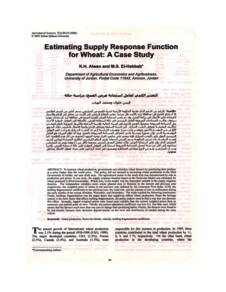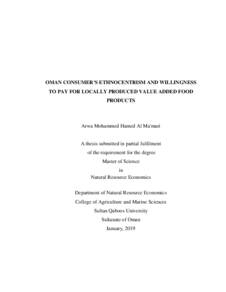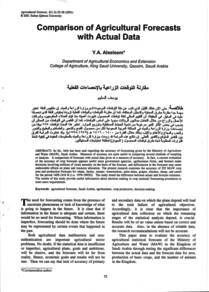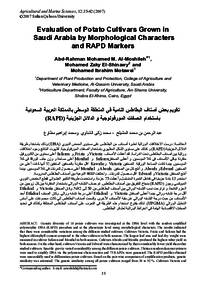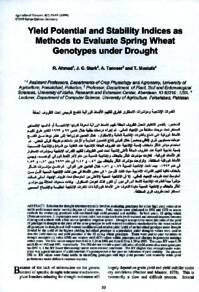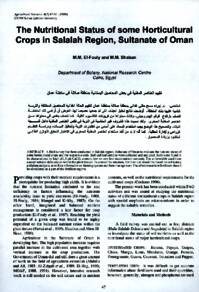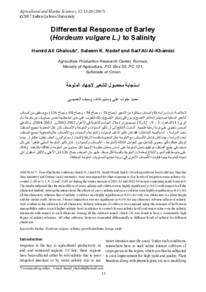وثيقة
Estimating supply response function for wheat a case study.
المساهمون
EIhabbab, M.S., مؤلف
الناشر
Sultan Qaboos university
ميلادي
2002
اللغة
الأنجليزية
الملخص الإنجليزي
To increase wheat production, governments can subsidize wheat farmers by purchasing their produce at a price higher than the world price. This policy did not succeed in increasing wheat production in the Irbid Governorate of Jordan, our case study area. The agricultural sector in the study area was characterized by risk in production and prices. In our study, the supply response function based on the Nerlovian Model was estimated for wheat produced in Irbid Governorate. Wheat area, in the model, was the dependent variable in the supply response function. The independent variables were: wheat planted area in Dunums in the current and previous year respectively, the weighted price of wheat in the previous year deflated by the Consumer Price Index (CPI), the holding fragmentation coefficient in the previous year, the yield risk, and the amount of rain in millimeters during the early months of the season (October, November, and December). The study reached the following conclusions: Firstly, holdings fragmentation was the major factor that negatively affects wheat production. Since the heritage system is the main factor that affects holding fragmentation, the policy makers need to find a way that can decrease this effect. Secondly, lagged weighted prices were found more suitable than the current weighted prices from an economic and statical point of view. Thirdly, the partial adjustment cocfficient was low (i.e. less than one), which means that the farmers need more than one year to change their producing habits. Finally, the farmers were found to be risk-neutral, because their decisions depend mainly on the level and distribution of rainfall during the rainy season.
المجموعة
ISSN
2410-1079
URL المصدر
zcustom_txt_2
Alwan, K. H., & EIhabbab, M. S. (2002). Estimating supply response function for wheat: a case study. Journal of Agricultural and Marian Sciences, 7 (1), 29-35.
الملخص العربي
بالرغم من الدعم الذي تقدمه الحكومة الأردنية لشراء القمح من المزارعين بسعر أعلى من السعر العالمي إلا أن إنتاج القمح في محافظة اربد بالأردن ظل متدنيا. يعاني القطاع الزراعي في الأردن من مخاطر في الإنتاج والأسعار لاعتماده على الأمطار في زراعة القمح. وقد تم تقدير استجابة العرض للقمح المنتج في محافظة اربد باستخدام نموذج نيرلوف. وكانت المساحات المزروعة العامل الرئيسي في دالة استجابة العرض. بالإضافة إلى العوامل المؤثرة الأخرى مثل المساحة المزروعة بمحصول القمح بالدونم في السنة الحالية والسنة السابقة والأسعار الموزونة بالرقم القياسي لتكاليف المعيشة ومعامل التفتت الحيازي في السنة السابقة ومخاطر الإنتاج وكمية الأمطار بالمليمتر خلال الشهور الأولى من الموسم (أكتوبر ونوفمبر وديسمبر). وتوصلت الدراسة إلى أن التفتت الحجازي هو أحد أهم العوامل المؤسسية التي تؤثر بصورة رئيسية على انخفاض المساحة المزروعة بالقمح. وبما أن نظام الميراث هو العامل الرئيسي المؤثر على التفتت الحيازي فإنه يتحتم على صانعي القرار توجيه الجهود للتخفيف من آثار هذه الظاهرة. كما أوصت الدراسة بأن تتبنى الحكومة سعر العرض اعتمادا على الرقم القياسي لتكاليف المعيشة ليعكس السعر الحقيقي الذي يؤثر على استجابة العرض. وكان معامل التعديل الجزئي منخفضا (أقل من 1) وهذا يعني أن المزارعين يحتاجون إلى أكثر من سنة لتعديل المساحة المزروعة استنادا إلى العوامل المؤثرة على دالة استجابة العرض، وأخيرا وجد أن المزارعين هم من النوع متعادلي المخاطرة ويعتمدون في اتخاذ قراراتهم على معدل هطول الأمطار ومناطق هطولها.
قالب العنصر
مقالات الدوريات

